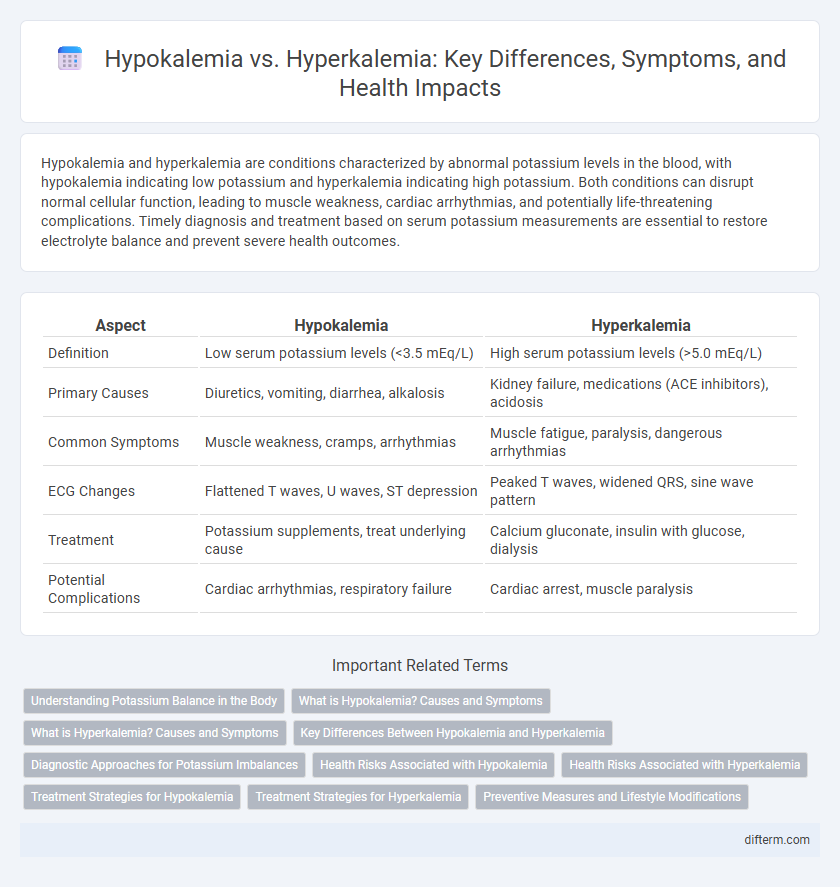Hypokalemia and hyperkalemia are conditions characterized by abnormal potassium levels in the blood, with hypokalemia indicating low potassium and hyperkalemia indicating high potassium. Both conditions can disrupt normal cellular function, leading to muscle weakness, cardiac arrhythmias, and potentially life-threatening complications. Timely diagnosis and treatment based on serum potassium measurements are essential to restore electrolyte balance and prevent severe health outcomes.
Table of Comparison
| Aspect | Hypokalemia | Hyperkalemia |
|---|---|---|
| Definition | Low serum potassium levels (<3.5 mEq/L) | High serum potassium levels (>5.0 mEq/L) |
| Primary Causes | Diuretics, vomiting, diarrhea, alkalosis | Kidney failure, medications (ACE inhibitors), acidosis |
| Common Symptoms | Muscle weakness, cramps, arrhythmias | Muscle fatigue, paralysis, dangerous arrhythmias |
| ECG Changes | Flattened T waves, U waves, ST depression | Peaked T waves, widened QRS, sine wave pattern |
| Treatment | Potassium supplements, treat underlying cause | Calcium gluconate, insulin with glucose, dialysis |
| Potential Complications | Cardiac arrhythmias, respiratory failure | Cardiac arrest, muscle paralysis |
Understanding Potassium Balance in the Body
Hypokalemia and hyperkalemia represent imbalances in potassium levels, critical for maintaining proper cell function, especially in muscle and nerve cells. Hypokalemia occurs when potassium levels fall below 3.5 mEq/L, causing muscle weakness, arrhythmias, and fatigue, while hyperkalemia, with levels above 5.0 mEq/L, can lead to dangerous cardiac arrhythmias and muscle paralysis. Maintaining potassium balance involves kidney function regulation, dietary intake, and hormonal control by aldosterone to prevent these potentially life-threatening conditions.
What is Hypokalemia? Causes and Symptoms
Hypokalemia is a medical condition characterized by abnormally low potassium levels in the blood, typically below 3.5 mmol/L, which disrupts cellular function and muscle contraction. Common causes include excessive potassium loss from vomiting, diarrhea, diuretic use, or chronic kidney disease, as well as inadequate dietary intake. Symptoms often involve muscle weakness, cramps, fatigue, irregular heart rhythms, and in severe cases, paralysis or respiratory difficulties.
What is Hyperkalemia? Causes and Symptoms
Hyperkalemia is a medical condition characterized by elevated potassium levels in the bloodstream, typically above 5.0 mmol/L. Common causes include kidney dysfunction, excessive potassium intake, certain medications such as ACE inhibitors or potassium-sparing diuretics, and conditions like Addison's disease. Symptoms often involve muscle weakness, fatigue, irregular heartbeats, and in severe cases, life-threatening cardiac arrhythmias.
Key Differences Between Hypokalemia and Hyperkalemia
Hypokalemia is characterized by serum potassium levels below 3.5 mEq/L, leading to muscle weakness, cramps, and cardiac arrhythmias, whereas hyperkalemia involves potassium levels above 5.0 mEq/L, increasing the risk of life-threatening cardiac conduction abnormalities. Hypokalemia often results from diuretic use, gastrointestinal losses, or inadequate intake, while hyperkalemia is commonly caused by renal failure, potassium-sparing medications, or cell lysis. Electrocardiogram findings differ: hypokalemia may show flattened T waves and U waves, whereas hyperkalemia presents peaked T waves and widened QRS complexes.
Diagnostic Approaches for Potassium Imbalances
Diagnostic approaches for potassium imbalances involve serum potassium level measurement as the primary test to distinguish hypokalemia from hyperkalemia, with values below 3.5 mEq/L indicating hypokalemia and above 5.0 mEq/L signaling hyperkalemia. Electrocardiograms (ECG) provide critical insights by revealing characteristic changes such as flattened T waves and U waves in hypokalemia or peaked T waves in hyperkalemia. Additional diagnostics include assessing renal function, acid-base balance, and conducting urine potassium tests to determine underlying causes and guide effective treatment strategies.
Health Risks Associated with Hypokalemia
Hypokalemia, characterized by low potassium levels in the blood, increases the risk of muscle weakness, arrhythmias, and respiratory complications, posing significant threats to cardiac and neuromuscular health. Severe hypokalemia can lead to life-threatening conditions such as ventricular fibrillation and paralysis. Early detection and management are crucial to prevent these serious health risks and maintain electrolyte balance.
Health Risks Associated with Hyperkalemia
Hyperkalemia, characterized by elevated potassium levels above 5.0 mmol/L, poses significant health risks including cardiac arrhythmias, muscle weakness, and in severe cases, life-threatening cardiac arrest. This electrolyte imbalance disrupts normal electrical conduction in the heart, increasing the risk of ventricular fibrillation and sudden death. Prompt diagnosis through serum potassium measurement and management, such as calcium gluconate administration and potassium-lowering therapies, are critical to prevent complications.
Treatment Strategies for Hypokalemia
Treatment strategies for hypokalemia primarily involve oral or intravenous potassium supplementation to restore normal serum potassium levels, with doses adjusted based on severity and underlying causes. Identifying and managing contributing factors such as diuretic use, gastrointestinal losses, or magnesium deficiency is crucial to prevent recurrence. Close monitoring of cardiac function and serum potassium levels ensures safe correction and reduces the risk of complications like arrhythmias.
Treatment Strategies for Hyperkalemia
Treating hyperkalemia involves stabilizing cardiac membranes with intravenous calcium gluconate to prevent arrhythmias, shifting potassium intracellularly using insulin and glucose, and enhancing potassium removal through diuretics, sodium polystyrene sulfonate, or dialysis in severe cases. Managing underlying causes such as renal failure or medication-induced potassium retention is critical in preventing recurrence. Continuous monitoring of serum potassium levels and cardiac function ensures effective treatment and reduces the risk of life-threatening complications.
Preventive Measures and Lifestyle Modifications
Maintaining balanced potassium levels through a diet rich in fruits, vegetables, and whole grains helps prevent hypokalemia and hyperkalemia. Regular monitoring of potassium levels, especially for individuals with kidney disease or those on diuretics, is essential for early detection and management. Avoiding excessive potassium intake from supplements and managing underlying conditions like hypertension contribute significantly to maintaining potassium homeostasis.
Hypokalemia vs Hyperkalemia Infographic

 difterm.com
difterm.com